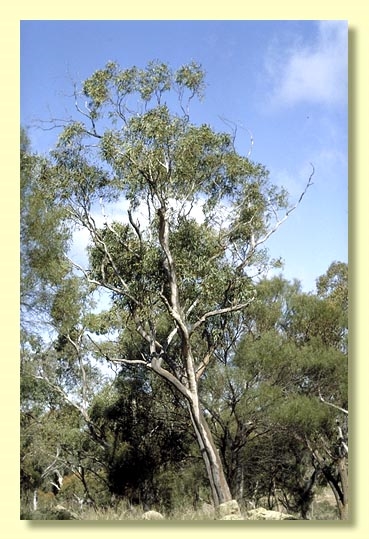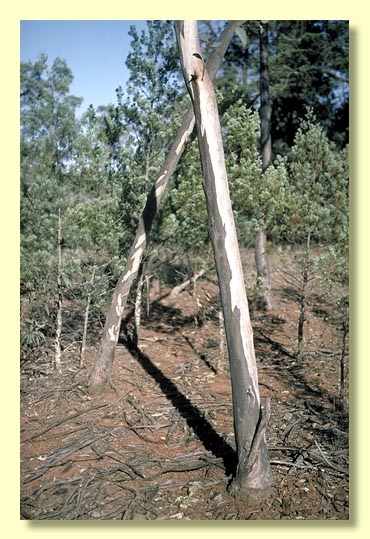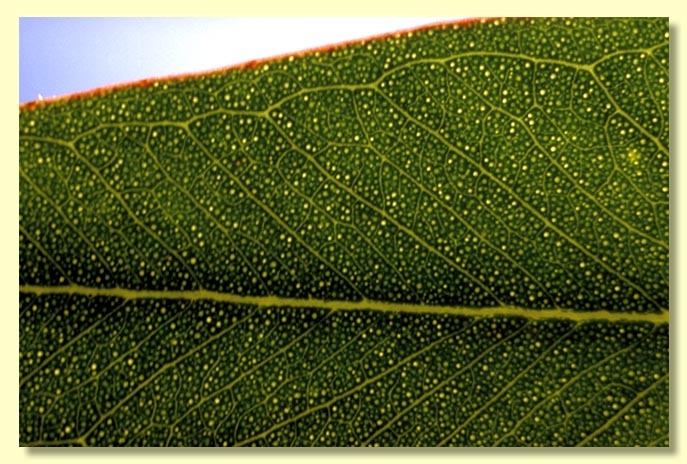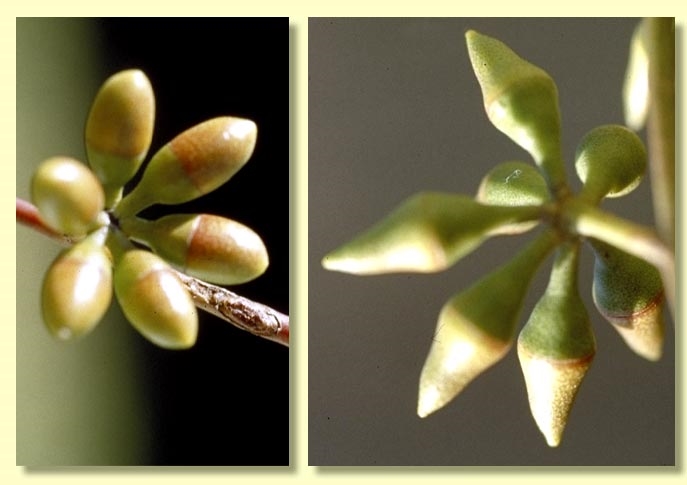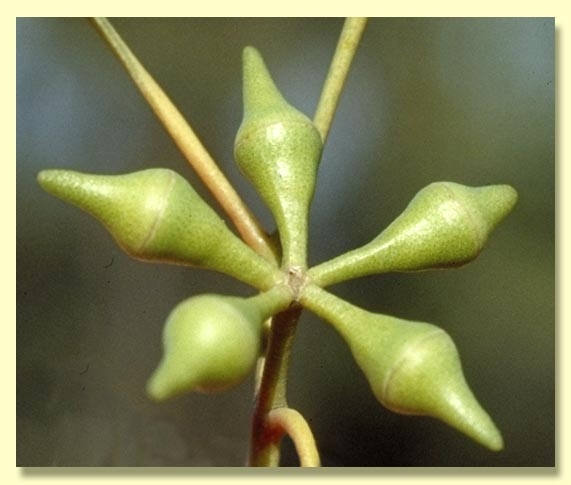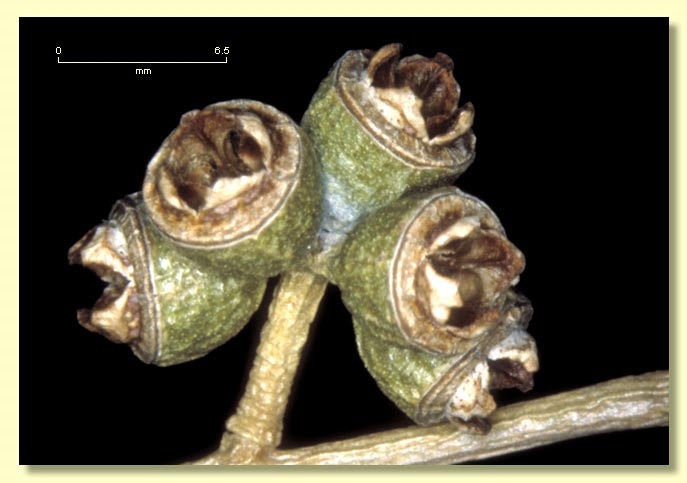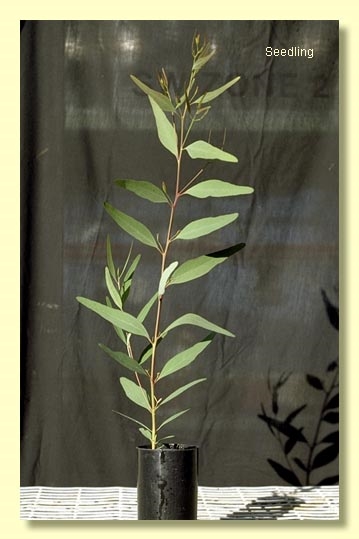Euclid - Online edition
Eucalyptus dwyeri
Eucalyptus | Symphyomyrtus | Exsertaria | Erythroxylon
T: Gungal, NSW, Sept. 1904, J.L.Boorman s.n.; syn: NSW (2 sheets), MEL.
Bark smooth throughout, rarely with a few loose basal slabs of rough bark; smooth bark white or cream with grey, orange or brown patches, sometimes powdery.
Juvenile growth (coppice or field seedlings to 50 cm): stems round or square in cross-section; juvenile leaves always petiolate, opposite for 4 to 6 pairs then alternate, lanceolate to narrowly lanceolate or even linear, 5–15 cm long, 1–2.5 cm wide, green.
Adult leaves alternate, petiole 1–2.2 cm long; blade lanceolate to falcate, 7–15 cm long, 1–2.7 cm wide, base tapering to petiole, concolorous, glossy or dull, green, side-veins usually greater than 45° to midrib, sparsely to moderately reticulate, intramarginal vein parallel to and remote from margin, oil glands mostly island.
Inflorescence axillary unbranched, peduncles (0.3)0.5–1 cm long, buds 7, sessile or pedicellate (pedicels 0–0.5 cm long). Mature buds ovoid to diamond-shaped (0.6–1.3 cm long, 0.3–0.6 cm wide), yellow or cream, scar present, operculum conical (0.3–0.8 cm long), sometimes rounded or even beaked, outer stamens erect, some terminally deflexed, inner stamens regularly inflexed, anthers cuboid to oblong, versatile, dorsifixed, dehiscing by longitudinal slits (non-confluent), style long, stigma blunt to tapered, locules 3 or 4, the placentae each with 6 vertical ovule rows. Flowers white.
Fruit sessile or pedicellate (pedicels 0–0.5 cm long), cup-shaped, cylindrical, obconical, campanulate or hemispherical, 0.3–0.9 cm long, 0.5–0.7 cm wide, sometimes with slight angles, disc raised-convex to level, valves 3 or 4, exserted or near rim level.
Seeds dark brown or black, 0.8–1.4 mm long, pyramidal or cuboid, dorsal surface pitted, edges minutely toothed, hilum terminal.
Cultivated seedlings (measured at ca node 10): cotyledons reniform to oblong; stems square or rounded in cross-section; leaves petiolate, opposite for 4 to 6 nodes then becoming alternate, narrowly lanceolate to lanceolate, 7–12 cm long, 1–2.5 cm wide, base tapering, apex pointed, dull, green.
Flowering has been recorded in September, October, November and December.
A small tree or mallee of elevated sandstone areas of the upper Hunter Valley (e.g. Denman to Gungal) and the central western slopes and adjacent part of the north-western slopes and south-western slopes of New South Wales, west to near Lake Cargelligo and south-west to Griffith and Narrandera. E. dwyeri is a conspicuous small smooth-barked tree of the numerous rocky hills in this area. It is notable for the narrow juvenile leaves.
Eucalyptus dwyeri belongs to the group of red gums which is distinguished by having buds with the stamens mostly erect, fruit where the disc is united to the ovary roof and by the black, toothed, cuboid to pyramidal single-coated seed. Fifteen species belong to this group: E. amplifolia, E. blakelyi, E. chloroclada, E. dealbata, E. dwyeri, E. flindersii, E. gillenii, E. glaucina, E. infera, E. kabiana, E. nandewarica, E. nudicaulis, E. tereticornis, E. terrica and E. vicina.
E. dwyeri is usually confused with E. dealbata, E. blakelyi and E. vicina. These three can be distinguished by having ovate juvenile leaves while typical E. dwyeri has lanceolate to narrowly lanceolate juveniles (1–2.5 cm wide in E. dwyeri and 3–4.2 cm for E. dealbata, 3.3–7 cm wide for E. blakelyi and 2.5–5 cm wide in E. vicina). E. dealbata can be further distinguished by always having very glaucous buds and fruits. At the edges of the geographic range of E. dwyeri zones of integradation occur. West towards Monia Gap and north-west of the Lachlan River, E. dwyeri intergrades with E. vicina. South around Temora, Wagga Wagga and The Rock and in some parts of the Hunter Valley, E. dwyeri intergrades with E. blakelyi. In all these intergrade areas the juveniles leaves are much broader than is typical for E. dwyeri and longer than is usual for either of the other species involved.
E. nandewarica, from an enclave in foothills near Kaputar north-east of Coonabarabran, E. gillenii, from the central and south-western part of central Australia, and E. nudicaulis from the Mt Isa region in the north-western part of Queensland all have the narrow juveniles like E. dwyeri. E. nandewarica differs only marginally by the slightly smaller buds and fruit (sometimes in threes). E. gillenii and E. nudicaulis are distinguished by having much larger fruit, usually greater than 0.7 cm wide and usually narrower than 0.7 cm in E. dwyeri.
Other related red gum species to consider are E. amplifolia from subcoastal and tableland areas of New South Wales and south-east Queensland, E. tereticornis, a common tree in eastern Australia from Bega to the tip of Cape York Peninsula and E. glaucina from the low coastal ranges and tablelands of central-northern New South Wales. All differ by having large ovate to orbicular to deltoid juvenile leaves. E. tereticornis can be further separated by having buds with a much longer narrower operculum than E. dwyeri. E. kabiana, from Mt Beerwah in the Glasshouse Mountains, also differs by having buds with a longer narrow operculum like E. tereticornis. E. chloroclada from the western slopes and plains of New South Wales, from the Pilliga area northwards into the Texas, Cracow, Tambo, Dirranbandi area of south-east Queensland and E. terrica, from the Inglewood and Warwick region of south-east Queensland differ by normally having some rough bark on their trunk. E. infera, an odd eucalypt from the Warwick region in Queensland, has typical red gum buds and fruit but has juvenile leaves similar to the swamp gum E. camphora that are ovate to orbicular, with an emarginate apex and margins often with shallow crenulations. E. flindersii, from the slopes and summits of peaks in the Northern Flinders Range and hills south-east of there in South Australia, has broadly ovate to ovate, dull, green to grey-green juvenile leaves and inflorescences which are commonly three-budded in each umbel.
In the Hunter Valley region, E. dwyeri may also be confused with E. parramattensis, another smooth-barked red gum from the series Liberivalvae. E. dwyeri can be distinguished by having fruit with a level to ascending disc that is fused to the ovary roof, unlike the level annular disc of series Liberivalvae that is free from the ovary roof.
MORE ABOUT RED GUMS AND OTHER ASSOCIATED GROUPS

